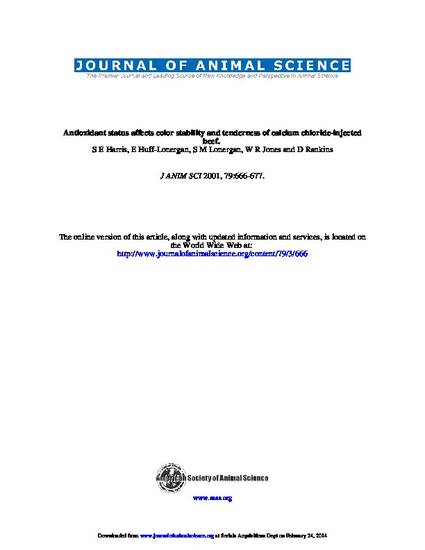
The objectives of this study were to determine whether vitamin E supplementation influences color and tenderness of beef injected with calcium chloride. Market heifers (n = 12) were fed a standard finishing diet with minimal levels of vitamin E (NE group). Another 12 market heifers were fed the NE diet with the inclusion of 1,000 IU/d of DL-alpha-tocopherol per animal for the last 125 d on feed (E group). Animals were slaughtered after 125 d on the diets and upon reaching an ultrasound backfat thickness > 10 mm. Half of the longissimus muscles from each treatment group (NE and E) were pumped to 10% over the original weight with 250 mM CaCl2 (Ca) at 24 h postmortem. Remaining muscles (NE and E) were pumped to 10% over the original weight with water (NC) at 24 h postmortem. After equilibrating overnight, steaks (2.54 cm) were overwrapped with O2-permeable film and stored for 7 d after injection. Hunter "L," "a," and "b" values were obtained each day of storage. Trained panelists evaluated color on d 1, 4, and 7 after injection. 2-Thiobarbituric acid-reactive substances (TBARS) values were measured on d 1 and 7 after injection. Warner-Bratzler (W-B) shear force values and trained sensory panel evaluations at 1, 3, and 7 d after injection were obtained. Immunoblotting techniques were used to monitor the 30-kDa degradation product of troponin-T at 1, 3, and 7 d after injection. At 4 d after injection, E/Ca steaks were the least discolored (P < 0.05). The E/Ca steak TBARS values were not significantly different from values for NE/NC steaks at 7 d after injection, whereas NE/Ca steaks had greater (P < 0.05) TBARS values after 7 d following injection compared with all other groups. Treatment with Ca resulted in higher off-flavor scores (P < 0.05). The E/Ca samples had the most rapid tenderization and proteolysis of all treatment groups. Warner-Bratzler shear values were lower in the E/Ca samples than in the E/NC samples at 1, 3, and 7 d after injection (P < 0.05). No difference in shear force was noted between NE/Ca and NE/NC samples at any time point. No difference in sensory tenderness was noted between NE/Ca and NE/NC samples at 1 d after injection. However, Ca-injected samples (NE/Ca and E/Ca) were rated as being significantly more tender than their uninjected counterparts (NE/NC and E/NC) at 3 and 7 d after injection. Injection of CaCl2 may result in more rapid and immediate tenderization if beef from animals supplemented with vitamin E is used. Vitamin E incorporation into muscle tissue may potentiate the action of exogenously added calcium by protecting the calpains from oxidation.
Available at: http://works.bepress.com/steven_lonergan/85/

This article is from Journal of Animal Science 79 (2001): 666–677. Posted with permission.